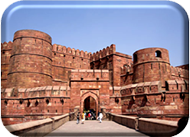 Day 06: Ranthmbore National Park - Fatehpur Sikri - Agra (199kms/04hrs) SAFARI AT PARK
Day 06: Ranthmbore National Park - Fatehpur Sikri - Agra (199kms/04hrs) SAFARI AT PARK
Morning enjoy safari to explore wild life at the park.
After breakfast at hotel drive to visit Fatehpur Sikri bears exceptional testimony to the Mughal civilization at the end of the 16th century. It offers a unique example of architectural ensembles of very high quality constructed between 1571 and 1585. Its form and layout strongly influenced the evolution of Indian town planning, notably at Shahjahanabad (Old Delhi).
The 'City of Victory' had only an ephemeral existence as the capital of the Mughal empire. The Emperor Akbar (1556-1605) decided to construct it in 1571, on the same site where the birth of his son, the future Jahangir, was predicted by the wise Shaikh Salim Chisti (1480-1572). This capital without a future, some 40 km from Agra was, however, considerably more than the fancy of a sovereign during the 14 years of its existence. The city, which the English traveller Ralph Fitch considered in 1585 as 'considerably larger than London and more populous', comprised a series of palaces, public buildings and mosques, as well as living areas for the court, the army, servants of the king and for an entire population whose history has not been recorded.
Later continue drive to Agra.
 Agra, situated on the west bank of River Yamuna, Agra was once the flourishing capital of the Muslim rulers of India. Two great Mughal monarchs, Akbar and Shah Jahan, transformed the little village of Agra into a befitting second capital of the Mughal Empire - giving it the name Dar-ul-Khilafat {seat of the Emperor}. Today a visitor to Agra is caught up in a world of contrasting edifices, of red sandstone and white marble, narrow galleys and quaint buggies, and that irresistible charm that this favorite city of the Mughals still retains. It is not surprising, that modern Agra still reflects its Mughal heritage most conspicuously.
Agra, situated on the west bank of River Yamuna, Agra was once the flourishing capital of the Muslim rulers of India. Two great Mughal monarchs, Akbar and Shah Jahan, transformed the little village of Agra into a befitting second capital of the Mughal Empire - giving it the name Dar-ul-Khilafat {seat of the Emperor}. Today a visitor to Agra is caught up in a world of contrasting edifices, of red sandstone and white marble, narrow galleys and quaint buggies, and that irresistible charm that this favorite city of the Mughals still retains. It is not surprising, that modern Agra still reflects its Mughal heritage most conspicuously.
On arrival check in at hotel. Rest of the day free for leisure activites. Overnight at hotel.
 Day 01: Arrive Delhi
Day 01: Arrive Delhi 


 Day 02: Delhi - CYCLE RICKSHAW RIDE
Day 02: Delhi - CYCLE RICKSHAW RIDE Day 03: Delhi - Jaipur (259 Kms / 6.5 hrs)
Day 03: Delhi - Jaipur (259 Kms / 6.5 hrs)  Day 04: Jaipur - ELEPHANT RIDE
Day 04: Jaipur - ELEPHANT RIDE  Optional Activities:
Optional Activities:  Day 05: Jaipur - Sawai Madhopur (Ranthambore National Park) (148 kms/ 03 hrs)
Day 05: Jaipur - Sawai Madhopur (Ranthambore National Park) (148 kms/ 03 hrs)  Day 06: Ranthmbore National Park - Fatehpur Sikri - Agra (199kms/04hrs) SAFARI AT PARK
Day 06: Ranthmbore National Park - Fatehpur Sikri - Agra (199kms/04hrs) SAFARI AT PARK  Agra, situated on the west bank of River Yamuna, Agra was once the flourishing capital of the Muslim rulers of India. Two great Mughal monarchs, Akbar and Shah Jahan, transformed the little village of Agra into a befitting second capital of the Mughal Empire - giving it the name Dar-ul-Khilafat {seat of the Emperor}. Today a visitor to Agra is caught up in a world of contrasting edifices, of red sandstone and white marble, narrow galleys and quaint buggies, and that irresistible charm that this favorite city of the Mughals still retains. It is not surprising, that modern Agra still reflects its Mughal heritage most conspicuously.
Agra, situated on the west bank of River Yamuna, Agra was once the flourishing capital of the Muslim rulers of India. Two great Mughal monarchs, Akbar and Shah Jahan, transformed the little village of Agra into a befitting second capital of the Mughal Empire - giving it the name Dar-ul-Khilafat {seat of the Emperor}. Today a visitor to Agra is caught up in a world of contrasting edifices, of red sandstone and white marble, narrow galleys and quaint buggies, and that irresistible charm that this favorite city of the Mughals still retains. It is not surprising, that modern Agra still reflects its Mughal heritage most conspicuously. Day 07: Agra - Delhi (203 kms / 4.5 hrs) / Departure
Day 07: Agra - Delhi (203 kms / 4.5 hrs) / Departure  Described by the Indian classical poet Tagore as a "tear on the face of eternity", the Taj Mahal is undoubtedly the zenith of Moghul architecture and quite simply one of the world's most marvellous buildings. Volumes have been written on it s perfection, and its image adorns countless glossy brochures and guide books; nonetheless, the reality never fails to overwhelm all who see it, and few words can do it justice.
Described by the Indian classical poet Tagore as a "tear on the face of eternity", the Taj Mahal is undoubtedly the zenith of Moghul architecture and quite simply one of the world's most marvellous buildings. Volumes have been written on it s perfection, and its image adorns countless glossy brochures and guide books; nonetheless, the reality never fails to overwhelm all who see it, and few words can do it justice.